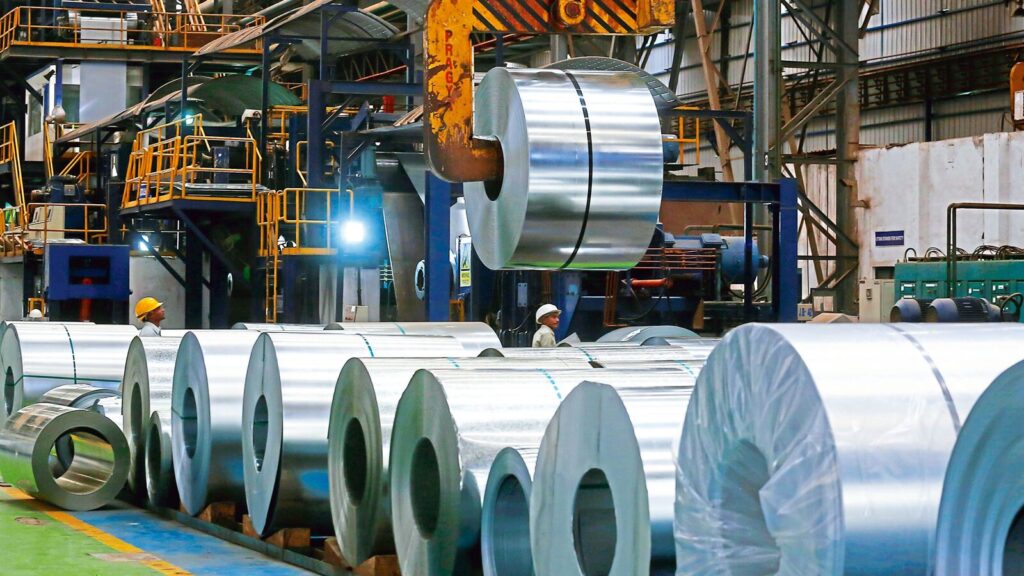New Delhi: The government on Monday imposed a 12% safeguard duty on steel imports in a move to protect the domestic steel industry.
The threat of a flood of cheap imports has risen post Trump’s tariffs that make it uneconomical for Chinese steel to sell to the US market.
As per a government notification issued on Monday by the ministry of finance, the safeguard duty would be applicable for 200 days with effect from Monday, 21 April.
“The safeguard duty imposed through this notification will remain in effect for 200 days from the date of its publication, unless it is earlier revoked, superseded, or amended,” the finance ministry notification stated.
The surplus Chinese steel now threatens to flood major markets, including India, with cheap products, creating an imbalance that could affect Indian steel companies.
Also read | India’s top steelmakers take diverging paths on iron ore sourcing
The notification from the finance ministry is being issued following the proposal by the Directorate General of Safeguards (DGS), which recommended a temporary safeguard duty for 200 days.
“The commerce ministry had recommended the safeguard duty proposal to the finance ministry for implementation via a notification,” a government official said.
The steel industry claims cheaper imports not just from China but also from Japan and South Korea impacted their profits and expansion plans.
Ranjan Dhar, director & vice president – sales and marketing at Arcelor Mittal Nippon Steel (AMNS), told a recent event to announce a green steel initiative, “The domestic steel industry needs protection as the Indian market does not have more appetite for imported steel that has already risen in recent months.”
”We welcome the government’s decision to impose a safeguard duty on certain steel imports. This is a critical step in addressing the surge of unfairly priced imports to India,” said T. V. Narendran, CEO & MD, Tata Steel. “As we have highlighted before, unchecked imports—especially from countries with significant excess capacity—threaten domestic manufacturing, employment, and future investments. This decision will help restore fair competition, ensure the industry’s long-term sustainability, and support India’s vision of a self-reliant and globally competitive steel sector.”
Earlier, Mint reported on 10 March that the DGTR had submitted its report recommending the imposition of up to 15% safeguard duty on steel imports.
The steel industry had earlier asked for at least a 25% safeguard duty on the metal, same as the US duty on steel and aluminium.
Officials explained that a safeguard duty is faster to implement and provides the desired results. It is needed to check cheaper imports as a substantial share of imports also come on the back of free trade agreements and raising the customs duty would not have helped check it. A safeguard duty will, however, be applicable on all imports and is a ‘complaint tax mechanism’ with all international trade pacts.
Government data shows India’s steel imports in FY25 soared to 9.5 million tonnes (mt), the highest since FY16, while exports crashed to a decade’s low of 5 mt. India has also become a net importer of the metal as last year country’s steel trade deficit hit a 10-year high of 4.5 mt.
Between FY16 and FY25, India’s steel imports have averaged in the 7 mt range, except in FY25 when it shot up 15% to 9.5 mt as compared to 8.3 mt in the previous year. Exports, which have been in the 8–9 mt range, dropped 35% y-o-y to 5 mt (vs 7.5 mt in FY24).
China is the biggest contributor to the rise in imports last year followed by South Korea and Japan. Vietnam, which is being used by Chinese companies, has been flagged by various government departments, has also been a big contributor to Indian steel imports.
Also read | Steel prices climb as ‘safeguard’ duty looms, user industries warn of inflation
Industry welcomed the move.
“These cheaper imports, especially from China, are not the best quality but the Indian industry buys it since it’s cheap. If this trend continues, Indian companies may have to reconsider their expansion plans. This will be a much-needed step in the right direction,” said an executive at a company, which is a large producer of long steel that is used in infrastructure projects.
“The government has finally come out with the much anticipated safeguard duty of 12% in a host of mild steel products which have seen an unusual spike in imports into India. This is much needed and a well timed move, though the quantum could have been a bit more.,” said Harsh Bansal, MD of BMW Industries.
“The move will help the Indian steel makers ensure they don’t move market to cheaper imports. The government will also have to ensure the headline inflation remains within target range. Even though this is a temporary measure, will bring relief to the steel industry,” said Bansal.
India’s steel production capacity is at 140 mt per annum and is planned to grow to a total crude steel capacity of 300 million tonnes by 2030-31 as per the National Steel Policy 2017.
Also read | Trump tariffs: No new shocks for Indian steel, aluminium, and auto makers
Apart from safeguard duty, the Directorate General of Trade Remedies (DGTR) under the Ministry of Commerce and Industry is already carrying investigations into dumping of steel. But this process is lengthy and usually takes upto a couple of years.
The plan to raise basic customs duty on steel was also discussed by steel and finance ministries but the measure was shot down on the grounds that it would have failed to provide duty protection to the domestic industry against FTA countries that accounts for around 75% of Indian steel imports.
Source:https://www.livemint.com/politics/policy/steel-safeguard-duty-steel-imports-chinese-dumping-trump-tariffs-cheap-imports-customs-duty-11745241362851.html

